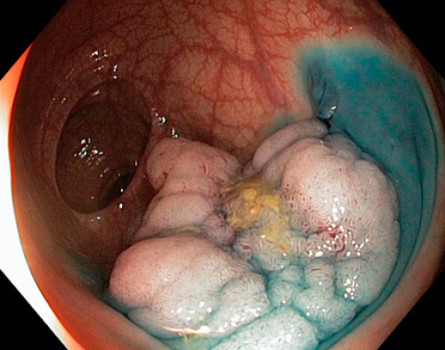
Although serrated polyps usually are associated with colorectal cancer, it turns out that such polyps are themselves not dangerous, according to a Norwegian study released this week in BMJ Gut, a journal on gastroenterology & hepatology.
“As a group, person with serrated polyps have an increased risk of intestinal cancer, on par with persons who have high risk adenomas. Our team discovered, however, that little happens in the polyps. This is not where the cancer develops. We believe, instead, that large, serrated polyps may be markers of increased cancer risk,” says Dr. Øyvind Holme, primary author of the study and PhD researcher at Norwegian hospital Sørlandet Sykehus.
Objective
Although serrated polyps may be precursors of colorectal cancer (CRC), prospective data on the long-term CRC risk in individuals with serrated polyps are lacking.
Design
In a population-based randomised trial, 12 955 individuals aged 50-64 years were screened with flexible sigmoidoscopy, while 78 220 individuals comprised the control arm. We used Cox models to estimate HRs with 95% CIs for CRC among individuals with ≥1 large serrated polyp (≥10 mm in diameter), compared with individuals with adenomas at screening, and to population controls, and multivariate logistic regression to assess polyp risk factors for CRC.
Results
A total of 103 individuals had large serrated polyps, of which 81 were included in the analyses. Non-advanced adenomas were found in 1488 individuals, advanced adenomas in 701. Median follow-up was 10.9 years. Compared with the control arm, the HR for CRC was 2.5 (95% CI 0.8 to 7.8) in individuals with large serrated polyps, 2.0 (95% CI 1.3 to 2.9) in individuals with advanced adenomas and 0.6 (95% CI 0.4 to 1.1) in individuals with non-advanced adenomas. A large serrated polyp was an independent risk factor for CRC, adjusted for histology, size and multiplicity of concomitant adenomas (OR 3.3; 95% CI 1.3 to 8.6). Twenty-three large serrated polyps found at screening were left in situ for a median of 11.0 years. None developed into a malignant tumour.
Conclusions
Individuals with large serrated polyps have an increased risk of CRC, comparable with individuals with advanced adenomas. However, this risk may not be related to malignant growth of the serrated polyp.
Story Source:
The above story is based on materials provided by Oslo University Hospital. Note: Materials may be edited for content and length.
Journal Reference:
- O. Holme, M. Bretthauer, T. J. Eide, E. M. Loberg, K. Grzyb, M. Loberg, M. Kalager, H.-O. Adami, O. Kjellevold, G. Hoff. Long-term risk of colorectal cancer in individuals with serrated polyps. Gut, 2014; DOI: 10.1136/gutjnl-2014-307793
